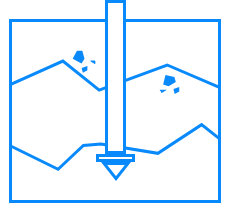Services

Cone Penetration Test
The Cone Penetration Test (CPT) is a fast and reliable means of conducting site investigations of soils and soft ground for several purposes. One of the most frequently used methods, the CPT offers a way to profile the subsurface soil layering at a particular site. This is a direct push method of data collection, which eliminates the need for drilling but also does not produce soil samples for laboratory testing. The CPT results in less disturbance to the soil strata and the surrounding environment than the Standard Penetration Test (SPT). The continuous nature of CPT readings results in an abundance of soil strata information. The CPT provides important parameters such as Tip Resistance, Inclination, Friction Ratio and Pore Pressure.
Levee Monitoring
Levees are embankments built to protect the land behind it from flooding, usually due to the overflow of rivers or other water bodies. Following the 2005 levee failures in Greater New Orleans that led to the tremendous loss of life and property, the role of levees grew in importance and public awareness. Levee monitoring involves the use of techniques such as remote sensing and in situ testing to assess the levee’s structural integrity, water levels, and the risks of failure which may be due to internal erosion, slope. Establishing routine health monitoring sessions of the state of levees is quite essential to predicting the possibility of failure and ensuring that the levees continue to serve their primary purpose.


Foundation Design
The foundations of structures are designed to transfer the load of the structure to the soil on which it rests. A properly designed foundation performs this function without the possibility of a failure due to excessive stresses or shear failure. Differential settlement and other factors can also lead to a failure of foundations. This makes the design of foundations a very important aspect of geotechnical engineering. The methods and procedure for the design of foundation vary based on the type of foundation (shallow or deep), the type of soil (cohesion or cohesionless), and expected dynamic load (such as earthquake, cyclic wind etc.) among other factors.
For any further questions and information,
please contact terraincengineering@gmail.com